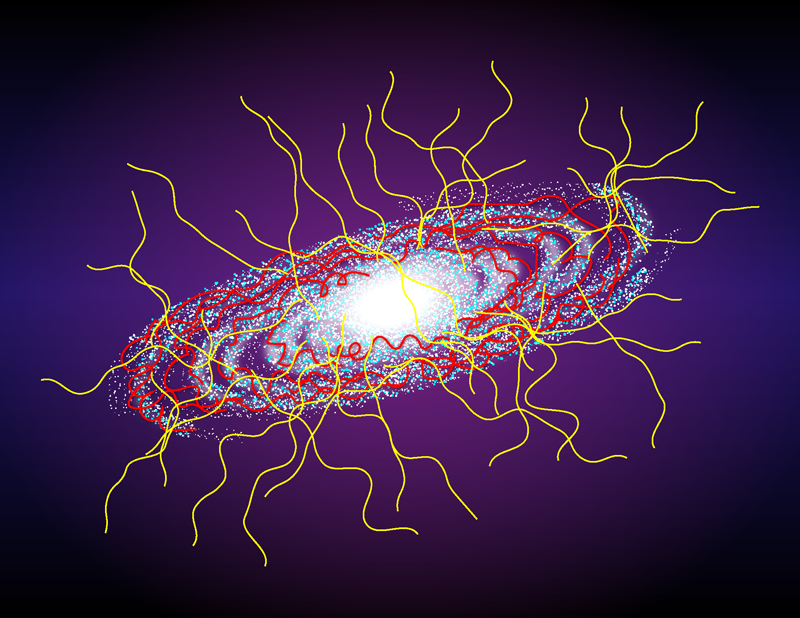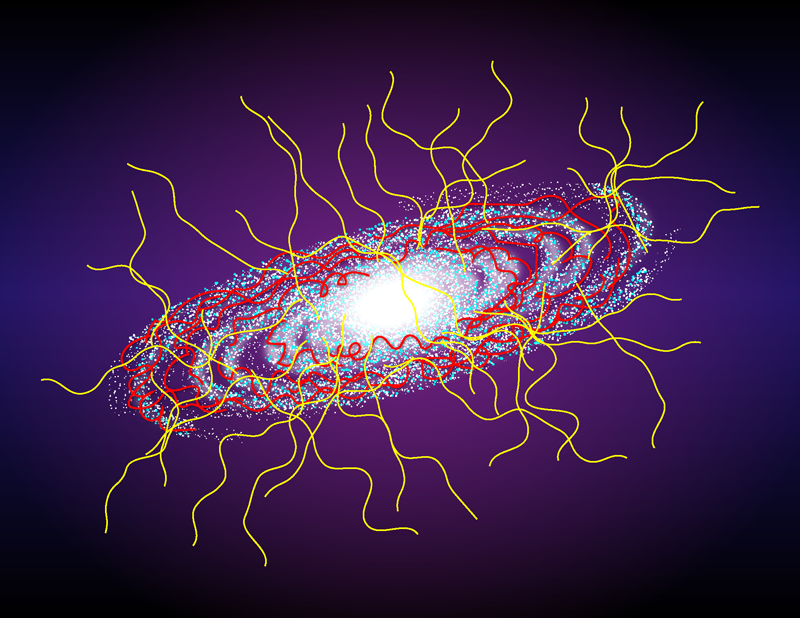Galaxy’s Gamma Glow Illuminates Cosmic-Ray Origins
Scientists know that the diffuse gamma-ray glow that suffuses the Milky Way is mainly produced by the interaction of high-energy cosmic rays with interstellar gas. But questions remain about the properties of these cosmic rays. What, for example, is their energy limit? And how do cosmic rays propagate from their sources? These long-standing mysteries could potentially be solved by observations of the highest-energy diffuse gamma rays. To this end, researchers working on the square kilometer array (KM2A) at the Large High Altitude Air Shower Observatory (LHAASO) experiment in China have reported precise measurements of the energy spectra of diffuse gamma rays over a wide energy range and across a large swath of the Galaxy [1]. Their results will give new insight into the propagation, interaction processes, and origin of the highest-energy cosmic rays in our Galaxy.
Since their discovery in 1912, cosmic rays—mainly comprising high-energy protons—have been observed across an energy range of more than 10 orders of magnitude. But in 1958, scientists found that the cosmic-ray flux decreases rapidly beyond an energy of a few PeV [2]. Researchers have explained this spectral cutoff by hypothesizing that cosmic rays accelerated to up to a few PeV are confined by the Galactic magnetic field for 104–107years and accumulate in a “cosmic-ray pool” (Fig. 1): these are the cosmic rays whose interactions with interstellar gas are responsible for most of the diffuse gamma rays. Cosmic rays above a few PeV, meanwhile, are thought to escape from our Galaxy, therefore contributing relatively little to the gamma-ray haze.
Studies of cosmic rays are hindered by the fact that the Galactic magnetic field deflects the particles’ trajectories, making it difficult to determine where they originate. Most cosmic rays arrive on Earth more or less equally from all angles, and even the highest-energy cosmic rays—which are deflected the least—carry little information about their sources. More insight can be gleaned from the gamma rays produced when cosmic rays interact with interstellar gas near where they were accelerated, because such radiation can travel without magnetic deflection. As a gamma ray typically carries 10% of the energy of its parent cosmic ray, the spatial and energy distributions of sub-PeV (0.1–1 PeV) gamma rays directly reflect those of the PeV cosmic rays that created them.
Indeed, detectors onboard satellites have observed the Galactic disk shining brightly with diffuse gamma rays at energies up to a few hundred GeV [3, 4], and in 2021 the Tibet AS𝛾 experiment reported the first detection of sub-PeV diffuse gamma rays (see Viewpoint: Signs of PeVatrons in Gamma-Ray Haze) [5]. That discovery by Tibet AS𝛾 provided the first experimental evidence that sub-PeV diffuse gamma rays are produced by protons—accelerated to energies of a few PeV—interacting with interstellar gas in our Galaxy. However, to reveal more detailed information about the propagation and origin of these cosmic rays, it is necessary to extend the measured energy range and the sky survey region and to increase the gamma-ray sensitivity.
This is where the LHAASO-KM2A results come in. The LHAASO-KM2A experiment was designed to observe gamma rays (and cosmic rays) up to around PeV energies using the surface air-shower detectors and the underground muon detectors at Haizi Mountain (4400 m above sea level) in China’s Sichuan province. These detectors employ the same detection principle as the Tibet AS𝛾 experiment, but the detection area (approximately 1 km2) is 15 times larger.
Recently, the LHAASO-KM2A team resolved more than 40 point-like (not diffuse) gamma-ray sources above 0.1 PeV [6]. In the new work, the researchers were therefore able to reduce the contribution that these previously unresolved sources make to the observed gamma-ray glow. With these high-energy sources masked, the team determined the detailed distribution of diffuse gamma rays in the Galactic disk over a wide range of energies (0.01–1 PeV) and Galactic longitudes (15°–235°). The Galactic latitude profiles of the diffuse gamma rays are in reasonable agreement with the distribution of interstellar gas, indicating that interaction of above-PeV-energy cosmic rays with interstellar gas is ubiquitous throughout our Galaxy. However, the Galactic longitude distributions are somewhat different from expectations. This discrepancy suggests either that additional unresolved gamma-ray sources are hidden in our Galaxy or that the cosmic-ray densities change depending on the location in our Galaxy. The energy spectrum measured by the LHAASO-KM2A team can be expressed by a single power law, and there is no obvious sign so far of the spectral cutoff expected at a few hundred TeV (corresponding to cosmic-ray energies of a few PeV). A future measurement of the upper energy limit will be essential to know the acceleration limit of protons in our Galaxy.
Detecting gamma rays is not the only way to probe the physics of cosmic rays, however. Very recently, the IceCube Collaboration reported measurements of Galactic diffuse neutrinos (at energies of 0.001–0.1 PeV) [7]. That result represents conclusive evidence for hadronic interactions—such as the interaction between cosmic rays and interstellar gas. The reason is that, whereas diffuse gamma rays below 0.1 PeV can possibly be created through leptonic processes involving electrons and positrons, neutrinos are produced through hadronic processes exclusively. Models that account for observations of both diffuse gamma rays and neutrinos should offer much insight into cosmic-ray origins.
As LHAASO is located about 29° north of the equator, the observatory can gather data from the Northern Sky only. Even stronger emissions of sub-PeV diffuse gamma rays are expected in the Southern Sky, including in the region of the Galactic Center, where interstellar gas and cosmic rays are concentrated. Several projects with wide-field-of-view air-shower detectors are planned for the Southern Hemisphere: the Andes Large-area PArticle detector for Cosmic-ray physics and Astronomy (ALPACA) [8], Mega-ALPACA [9], and Southern Wide-field Gamma-ray Observatory [10]. In the future, LHAASO and these other high-precision experiments should provide a complete picture of the most energetic cosmic rays in our Galaxy.
References
- Z. Cao et al. (LHAASO Collaboration), “Measurement of ultra-high-energy diffuse gamma-ray emission of the Galactic plane from 10 TeV to 1 PeV with LHAASO-KM2A,” Phys. Rev. Lett. 131, 151001 (2023).
- G. V. Kulikov and G. B. Khristiansen, “On the size distribution of extensive atmospheric showers,” J. Exp. Theor. Phys. 35, 635 (1958).
- S. D. Hunter et al., “EGRET observations of the diffuse gamma-ray emission from the Galactic plane,” Astrophys. J. 481, 205 (1997).
- M. Ackermann et al., “Fermi-LAT observations of the diffuse gamma-ray emission: Implications for cosmic rays and the interstellar medium,” Astrophys. J. 750, 3 (2012).
- M. Amenomori et al. (Tibet AS𝛾 Collaboration), “First detection of sub-PeV diffuse gamma rays from the Galactic disk: Evidence for ubiquitous Galactic cosmic rays beyond PeV energies,” Phys. Rev. Lett. 126, 141101 (2021).
- Z. Cao et al. (LHAASO Collaboration), “The first LHAASO catalog of gamma-ray sources,” arXiv:10.48550/arXiv.2305.17030.
- IceCube Collaboration et al., “Observation of high-energy neutrinos from the Galactic plane,” Science 380, 1338 (2023).
- C. Calle et al. (ALPACA Collaboration), “A new high energy gamma-ray observatory in the southern hemisphere: The ALPACA experiment,” J. Phys.: Conf. Ser. 1468, 012091 (2020).
- T. Sako et al. (ALPACA Collaboration), “Mega ALPACA to explore multi-PeV gamma-ray sky in the southern hemisphere,” PoS (ICRC2023) 444, 632 (2023).
- P. Huentemeyer (SWGO Collaboration), “The Southern Wide-field Gamma-ray Observatory (SWGO): A next-generation ground-based survey instrument,” Bulletin of the AAS 51, 109 (2019), https://baas.aas.org/pub/2020n7i109.





